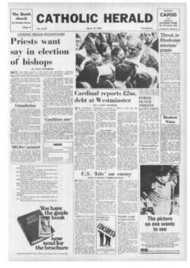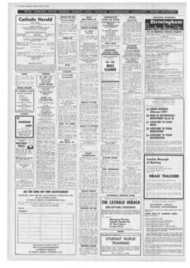Page 6, 14th March 1969
Page 6

Report an error
Noticed an error on this page?If you've noticed an error in this article please click here to report it.
Tags
Share
Related articles
Teilhard, The Man
Triumphant Exile Of A Philosophic Prophet
Does Teilhard Conflict With Old Beliefs?
Clearing Up The Clouds Obscuring Teilhard
Holy Office Warns
Two views of
Teilhard
Letters to Leontine Zanta Pierre Teilhard de Chardin (Collins 21s.) 'PHIS is the sixth volume of
Teilhard's letters to appear in English. It is the most personal and the most interesting of these collections. Leontine Zanta was a most remarkable woman. She possessed a fine intelligence, was a trained philosopher and a most accomplished person. Judging by those who were her friends and admirers she must have possessed great personal warmth of character and a rare gift for friendship.
The letters cover a period from 1923 to 1939. They are very varied in character. Some of them describe his work and travels, others the people with whom he came into contact. Many arc directed to a discussion of his ideas. His hopes, ideals and fears come across strongly, as does the way in which he viewed his own work. In some of the later letters his personal sufferings, inflicted by his own Church, come through more clearly than in anything previously published. Through them all runs the thread of a deep personal relationship. They were never intended for publication and some of the terms and expressions used in describing his ideas lack the precision found in works intended for publication.
There are two very useful introductions to the book. One is by Robert Gerrit who knew both Teilhard and Mlle Zanta and which provides a background to the letters. The other is by Fr. de Lubac who deals especially with Teilhard's personal sufferings. To those who are interested in Teilhard as a person, or in the development of his thought, these letters will provide further material for study.
Michael le Morvan
Teilhard Explained by Henri de Lubac (Paulist Press Deus Books 8s. 6d.) English title of
Teilhard, Missionaire et Apologiste is a misnomer; it is not an explanation of Teilhard but a close, difficult commentary.
In the first section, Teilhard's supposed affinities with St. Paul arc stressed, especially his incorporating modem evolutionary views into a "basic Christian conception," as Paul did with some of the Stoic views of his time. Hut Father de Lubac, like Teilhard himself and those who compare him with St. Thomas, forgets that, whereas in the old humanism Christus p ut abitur, in Tertullian's great phrase, the new humanism is a revolt against the light, which accounts for the uniquely disastrous nature of Teilhard's error.
In the second section, Teilhard's identification of Christ with his own Omega is accepted with only the slightest of reservations, and his optimism is vindicated. Father de Lubec is the chief Catholic' apologist for Teilhard; opposed to him is von Hildebrand, who wrote, in Trojan Horse in the City of God, that Teilhard's cult of equivocation "makes him even more dangerous than a Voltaire, a Renan. or a Nietzsche."
Edward McCarthy
blog comments powered by Disqus











